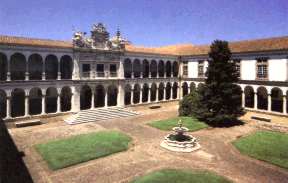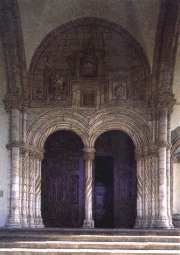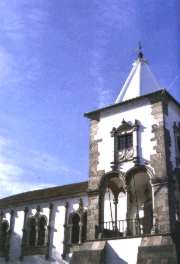|
|
|
|
WORLD HERITAGE SITES IN PORTUGAL
EVORA
EVORA
Roughly 150 km south east of Lisbon, Evora stands out quite distinctly on the vast horizon of the Alentejo plain, on the top of a gentle hill, dominated by its imposing cathedral. Its historical centre, protected by a vast ring of fortified walls, is typical of ''golden age'' cities, with its urban landscape exhibiting features from the architecture of countries in other continents where Portugal established a presence, particularly Brazil. The city has more than two millennia of history, its narrow streets evoking memories of the Moorish presence, in sharp contrast to its squares, which are flooded with sunlight. Definitively conquered by the Romans in 59 BC, it took the name of “Liberalitas Julia”. Dating from this time is its first city hall, which established its original perimeter.
Under the occupation of the Romans, Evora gained great importance as a city, a fact which is clearly borne out by the various remains from that period that are still visible today, particularly the ruins of a most elegant temple from the end of the second century AD, various sections of wall and the gate known as the Porta de Dona Isabel, as well as the ruins of the city's Roman baths under the present-day Town Hall.

There are very few remains left from the Visigothic period (between the fifth and the eighth century). After this came the period of Moorish domination, beginning with the conquest of the city by Tarik, which lasted until the Christian reconquest in the twelfth century. Yeborah, as the city became known, perfected its early defensive system and indelibly established traces of the Moorish influence in its toponymy, clearly visible in the Moorish quarter.After the Christian reconquest, a new urban sprawl began to spread out from the city's gates and beyond the old wall. The city was chosen by several kings of Portugal in the first and second dynasties to serve as the headquarters for their court, and it was greatly enriched with palaces and monuments, especially in the reigns of D. Joao II and D. Manuel I (fifteenth and sixteenth centuries).
You should begin your tour of the beautiful city of Evora with a visit to the cathedral a fortified church with a number of Gothic elements and the largest cathedral in Portugal. Outside, notice the two asymmetrical towers, one of which (the north tower) houses part of the valuable collection of the Sacred Art Museum. The main portal is flanked by a very expressive group of Apostles, seemingly inviting the visitor to enter.
Inside the cathedral, the nave and aisles end in the transept, with a beautiful dome above its crossing, which is a very rare feature in Portuguese churches. In the chancel, the high altar is a baroque reconstruction from the eighteenth century.
The nave contains the altar of Nossa Senhora do O (the Virgin Great with Child), whose multicoloured stone statue is matched by a statue of the Archangel Gabriel opposite. This latter figure is made of gilded wood and is attributed to Olivier of Ghent.
In the ''coro alto'' (upper choir) is a most valuable set of Renaissance choir stalls carved from oak. To their left is a sixteenth-century organ, the oldest one still in activity in Portugal.

Leaving the cathedral and turning right, you will find yourself in the square with the elegant Roman temple that is the city's most famous landmark. Opposite, the Pousada dos Loios has been installed in the restored building of the former Convento de Sao Joao Evangelista (fifteenth century), its pleasant atmosphere inviting you to rest awhile. Next door to this is the convent's church built at the end of the fifteenth century and well worth a visit. The Gothic doorway is the church's most notable feature, together with its covering of azulejos. Also in the vicinity is the Palacio dos Duques de Cadaval, surmounted by an imposing tower and a fine example of military architecture.If you walk down any one of the streets in front of the cathedral, you will soon come to Praca do Giraldo. With a public arcade on one side, this square acts as a kind of city forum, enlivened by its welcoming and friendly pavement cafes and with a beautiful sixteenth-century marble fountain surmounted by a bronze crown. The far end of the square is occupied by the Igreja de Santo Antao, built between 1557 and 1563.
Under the clear Alentejo sky, tracing your route on the map you have just picked up at the nearby tourist office, you should set out from this central square to discover a longstanding and ancient history that gradually reveals itself to you as you walk attentively around the city’s streets. There is also a whole history to be discovered in the names of the streets. In Rua das Casas Pintadas (the Street of the Painted Houses), a door opens onto a cool courtyard.
On one side, a small gallery exhibits paintings of fantastic mermaids, trees and animals from India, commissioned by Vasco da Gama when he lived in Evora.
If you walk down to the left from Praca do Giraldo, you will find the Igreja de Nossa Senhora da Graca, built in the Italian Renaissance style. It is a quite unique building, with a sturdy-looking facade and a heavy portico ending in a double open triangular pediment, with angels along the top. On each side, sitting on the top of the pilasters, are four muscular atlantes supporting enormous spheres with burning torches. Inside, your attention is drawn to the area around the high altar, with windows made of Estremoz marble, carved by Nicolau de Chanterenne.
Not far from the Igreja da Graca is the Igreja de Sao Francisco, which is also worthy of a special visit. The most notable feature on the facade is the porch with its arches built in different styles, both pointed and horseshoe, a typical example of the “marriage” between the Gothic and Moorish styles that is typically found in so many monuments in this region of Portugal.
The church has the peculiarity of consisting of one single nave ribbed vaulting, the largest such space to be found in Portuguese Gothic churches.
At the sides are twelve open chapels built between the buttresses of the walls, all of them lined with baroque wood carvings.

The chancel, built at the beginning of the sixteenth century, still has important Renaissance features, in the galleries for example, although the altarpiece was made at a later date. In the chapel of the Order of Terceira, situated in one of the arms of the transept, it is interesting to observe the harmonious blending together of stone, carved wood and azulejos. As well as the cloister and the chapel totally lined with human bones, the hermitage of Sao Joaozinho represents a nucleus of different styles, with its Renaissance portal, its panels of seventeenth-century azulejos and its baroque statues from the end of the eighteenth century.All that now remains of the former Paco Real de Sao Francisco opposite the convent is the Galeria das Damas. It was here that Vasco da Gama was appointed by D. Manuel I to serve as Commander of the Indian Fleet.
Returning to Praca do Giraldo, walk along Rua Serpa Pinto, or Rua de Alconchel, leading to the road to Lisbon. The gateway at the end of the street became the site for receiving illustrious figures whenever they came to visit Evora. It is also here that you will find the Convento de Santa Clara, founded in 1452, and one of the oldest in the city. In Rua do Raimundo, which also runs off from Praca do Giraldo, is the Convento das Merces, built in 1670, which is now the Evora Decorative Arts Museum, with interesting collections of church vestments and furniture. The old Jewish quarter lay between Rua Serpa Pinto and Rua dos Mercadores.
In Largo da Porta da Moura, besides the Mudejar-Manueline loggia of the Casa Cordovil and the window at the house of Garcia de Resende (who was the king's secretary, a poet and a chronicler), there is also a beautiful Renaissance fountain which deserves to be studied closely. Not far away is the old Universidade do Espírito Santo, founded in 1559. Since 1973, this has been the site of the present-day Universidade de Evora. Of particular interest in this building is the cloister with a double gallery, onto which open rooms that are still equipped with the old professor's chairs and benches from the scholastic days, and some magnificent allegorical azulejos referring to the various subjects that were lectured here. The Igreja do Colegio was carefully adapted for teaching purposes, as can be seen from the pulpit placed in the middle of the hall and its excellent acoustics. One of the chapels contains the large wooden crucifix that was always carried at the head of processions led by the Inquisition.
This is a region that has been inhabited by mankind since time immemorial, and all around Evora there is a remarkable heritage of megalithic monuments. You should also take advantage of your trip to visit the Cromlech of Almendres, a place of sublime mystery some 12 km from Evora, and the enormous dolmen of Zambujeiro.
Text provided by the Portuguese Tourist Office